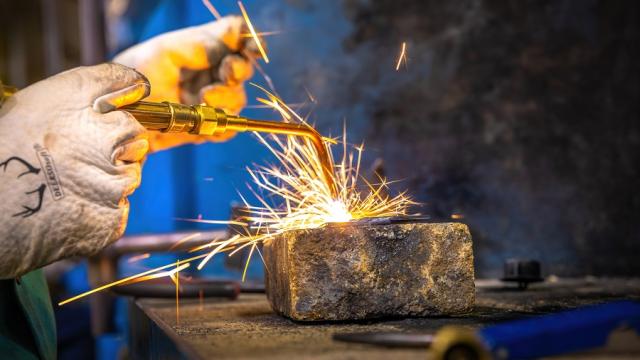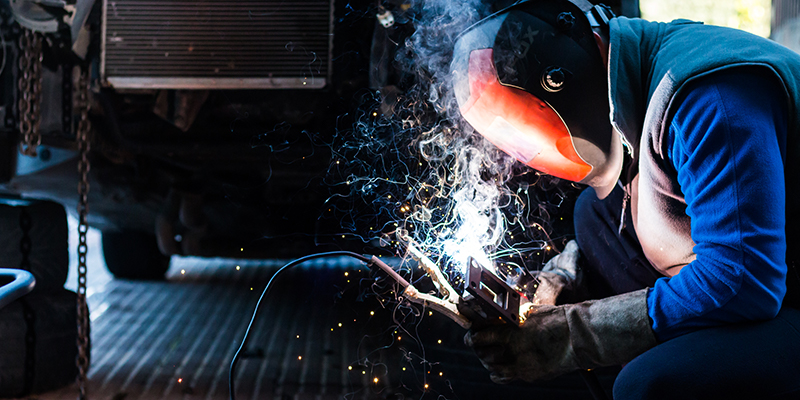Typical Welding Repair Service Issues and Just How to Address Them Properly
Welding fixings frequently experience a variety of issues that can jeopardize the stability of the end product. Typical issues include inadequate penetration, porosity, and misalignment, to name a few. Each issue presents distinct challenges that need particular techniques for resolution. Understanding these issues is necessary for welders intending to improve their results and skills. This discussion will certainly check out these common welding repair problems and effective techniques to address them.
Inadequate Infiltration
Inadequate infiltration takes place when the weld metal falls short to completely fuse with the base product, resulting in weak joints and possible architectural failures. This issue frequently comes from not enough warm input, incorrect electrode angle, or incorrect welding rate. Welders may come across insufficient infiltration because of a mistake of the required parameters for a specific product density or type. Additionally, contamination on the base material's surface area can prevent reliable bonding, intensifying the trouble. To deal with insufficient infiltration, welders ought to guarantee ideal setups on their tools and maintain a tidy work surface area. Regular examination of welds is advised to recognize any kind of shortages early, enabling prompt corrections and the prevention of jeopardized structural stability in bonded settings up.
Porosity
Porosity is a common flaw in welded joints that manifests as small gas bubbles caught within the weld steel. This problem can endanger the integrity of the weld, resulting in lowered stamina and prospective failing under anxiety. Fabrication. Porosity commonly occurs from contamination, wetness, or inappropriate welding techniques, which allow gases to leave into the molten weld pool. To deal with porosity, welders need to assure appropriate surface area preparation, preserve a clean functioning setting, and make use of ideal welding parameters. Furthermore, picking the ideal filler material and protecting gas can mitigate gas entrapment. Regular assessment and screening of welds can aid determine porosity early, assuring timely corrective actions are taken, thereby preserving the high quality and reliability of the welded structure
Imbalance
Misalignment in welding can emerge from different variables, consisting of improper arrangement and thermal development. Understanding the origin is vital for efficient resolution. Numerous adjustment strategies are offered to realign components and assure architectural integrity.
Sources of Imbalance
Welding misalignment frequently stems from a range of underlying problems that can compromise structural honesty. One key cause is incorrect fit-up of components prior to welding, which can lead to spaces and unequal surfaces. Variations in thermal development throughout the welding process can also result in distortion, especially if the materials being joined have various coefficients of development. Furthermore, inadequate fixturing and securing might stop working to hold elements securely in area, causing activity throughout welding. Inadequately kept devices, including welding equipments and tools, may introduce disparities in the weld grain, additional adding to misalignment. Lastly, operator mistake, originating from insufficient training or experience, can likewise play a substantial role in developing misaligned welds.
Adjustment Techniques Readily Available
Resolving imbalance successfully calls for a combination of restorative strategies tailored to the certain issues at hand. One usual approach is making use of jigs or fixtures to hold elements in the right setting during welding, ensuring constant positioning. Additionally, pre-heating the materials can assist decrease distortion and boost fit-up. For significant misalignment, mechanical adjustment techniques, such as utilizing hydraulic jacks or clamps, can be used to correct the setting prior to welding. Post-weld warm treatment might also be required to soothe stresses brought on by misalignment. Ultimately, cautious assessment and adjustment throughout the setup phase can prevent imbalance concerns from ending up being significant troubles, advertising a smoother welding procedure and boosting overall structural integrity.
Distortion
Distortion is an usual obstacle in welding that can develop from various aspects, including unequal heating & cooling. Recognizing the reasons of distortion is important for executing efficient avoidance strategies. Addressing this problem not just boosts structural stability however likewise boosts the overall high quality of the weld.
Root causes of Distortion
When subjected to the intense warm of welding, products frequently go through modifications that can result in distortion. This sensation mainly occurs from thermal development and tightening throughout the welding procedure. As the weld area warms up, the product broadens; upon cooling, it acquires, which can create interior anxieties. On top of that, you can look here irregular heating across a work surface can worsen these stresses, leading to bending or bending. The type of product likewise plays a significant function; metals with differing thermal conductivity and coefficients of growth may react differently, causing uncertain distortions. Furthermore, bad joint design and insufficient fixturing can add to imbalance during welding, enhancing the possibility of distortion. Understanding these causes is crucial for reliable welding repair and avoidance approaches.
Avoidance Techniques
Efficient prevention strategies for distortion throughout welding concentrate on managing warm input and guaranteeing appropriate joint style. Keeping a constant heat input helps to lessen thermal growth and contraction, which can result in distortion. Making use of techniques such as preheating the work surface can likewise reduce the temperature gradient, promoting uniform home heating. Furthermore, selecting ideal joint layouts, such as T-joints or lap joints, can improve stability and reduce stress and anxiety concentrations. Executing appropriate fixturing to safeguard the workpieces in position better aids in keeping alignment during the welding process. Ultimately, staggered welding series can distribute warm extra evenly, avoiding local distortion. By using these techniques, welders can substantially reduce the likelihood of distortion and enhance the total high quality of their welds.
Splitting
Breaking is an usual concern encountered in welding fixings, frequently resulting from numerous aspects such as improper air conditioning prices, material choice, or poor joint preparation. The occurrence of cracks can substantially endanger the honesty of the weld, resulting in possible failings throughout procedure. To address this problem, top article welders should first examine the origin triggers, making sure that materials work and properly picked for the details application. In addition, regulating the air conditioning rate throughout the welding process is crucial; quick air conditioning can generate stress and cause splitting. Correct joint style and preparation likewise add to minimizing the risk. Applying these approaches can enhance weld high quality and resilience, eventually lowering the possibility of fracturing in completed weldments.

Insufficient Combination
A substantial issue in welding repair services is incomplete fusion, which takes place when the weld metal does not effectively bond with the base material or previous weld passes - Montana Mobile Welding and Repair. This flaw can cause weak points in the joint, potentially compromising the integrity of the welded framework. Factors adding to incomplete fusion consist of inadequate warm input, improper welding technique, and contamination of the surface areas being signed up with. To address this issue efficiently, welders should assure appropriate pre-weld cleaning and surface prep work, along with adjust their welding specifications to accomplish ample penetration and blend. Regular examination throughout the welding procedure can also help determine incomplete combination early, enabling prompt corrective actions to enhance the overall quality of the weld
Overheating
While welding repair work can improve architectural stability, overheating offers a substantial challenge that can bring about product deterioration. Extreme warm during welding can modify the mechanical buildings of steels, leading to you can try here minimized stamina, enhanced brittleness, and bending. This phenomenon is particularly crucial in high-stress applications where structural reliability is critical. Recognizing getting too hot can entail aesthetic inspections for discoloration or distortion, as well as monitoring temperature level during the welding process. To reduce the threats connected with overheating, welders should use proper strategies, such as managing warm input, adjusting travel speed, and making use of ideal filler materials. In addition, carrying out pre- and post-weld heat therapies can aid bring back material residential or commercial properties and boost the general high quality of the repair, making sure lasting efficiency and security.
Often Asked Inquiries
What Are the Common Signs of a Welding Defect?

Just How Can I Examine My Welds for Quality?
To evaluate welds for high quality, one can use visual inspections, ultrasonic screening, and radiographic approaches. Each technique ensures structural integrity, identifies defects, and confirms adherence to defined requirements, inevitably boosting the integrity of the welded joints.
What Safety and security Precautions Should I Take While Welding?
When welding, one should focus on security by using ideal individual safety equipment, ensuring proper air flow, protecting flammable materials away, keeping a clean work space, and being conscious of environments to avoid accidents and injuries.
Can I Fix a Weld Without Renovating the Entire Joint?
Repairing a weld without redoing the whole joint is possible, depending on the damages (Welding). Strategies such as grinding, adding filler material, or making use of a welding procedure can effectively deal with certain imperfections while maintaining the surrounding framework
What Tools Are Essential for Effective Welding Repairs?
Vital tools for effective welding fixings consist of a welding maker, cord brush, grinder, safety gear, clamps, and filler materials. Each tool plays an important function in guaranteeing top quality and security throughout the repair service process. Porosity generally arises from contamination, moisture, or improper welding techniques, which allow gases to get away right into the molten weld pool. Badly kept equipment, consisting of welding machines and devices, might present inconsistencies in the weld bead, further contributing to misalignment. When subjected to the extreme warmth of welding, products frequently undergo changes that can lead to distortion. Breaking is a typical problem run into in welding fixings, frequently resulting from different factors such as improper air conditioning prices, product option, or insufficient joint prep work. A significant issue in welding repair services is insufficient blend, which happens when the weld steel does not sufficiently bond with the base product or previous weld passes.